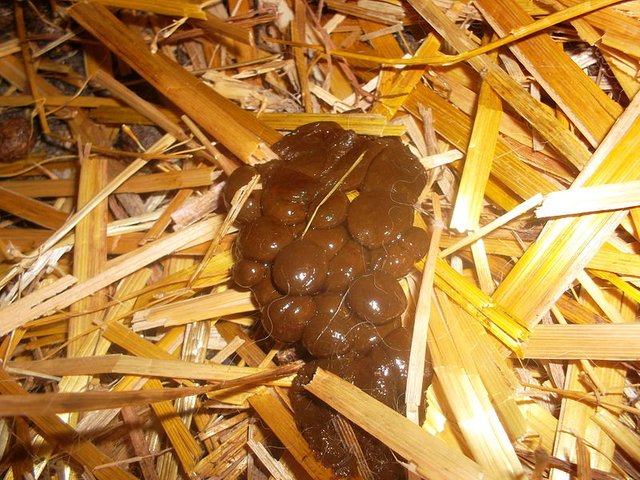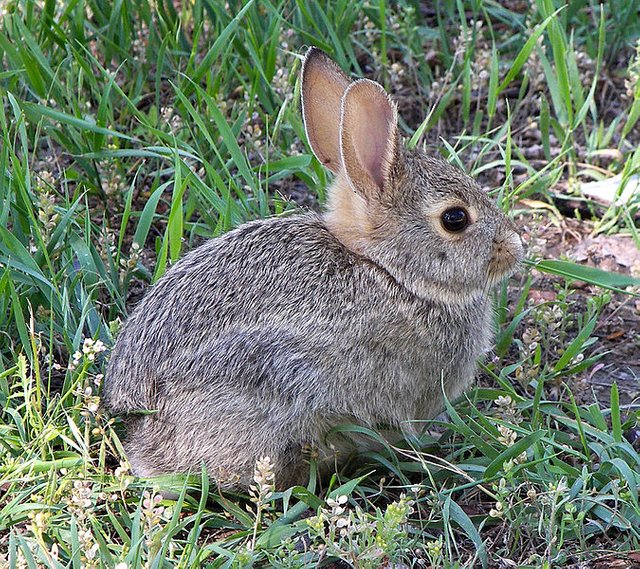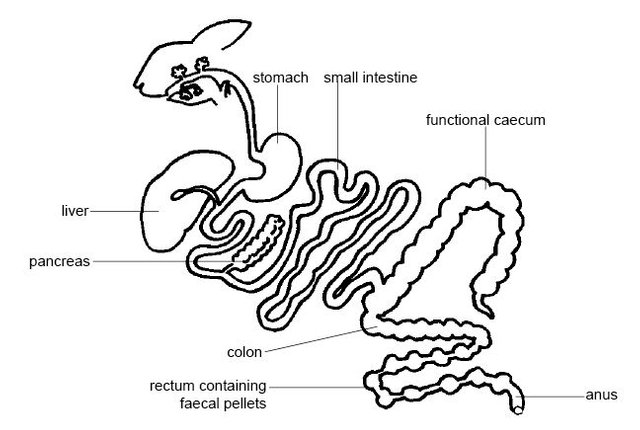HOW CONSUMPTION OF NIGHT FAECES HELPS A RABBIT
Welcome back to my blog, if this is your first time stopping by; thank you for your love and to those who believe in me – I appreciate you. To @steemstem, @stemng and @promo-mentors community, you’ve given me a reason to impact humanity and a food for thought.
Oops! Did I just say food? And Yes! I did and that’s exactly where we are headed in today’s lesson – Coprophagy: eating of faeces but you can find time to educate you on my previous posts via here .
But today’s topic is kinda interesting, don’t you think? What sort of animal consumes their excreta? Being a rabbit means that it has a lot of impact on their health and survival. You are curious, right? Why would they do that? How does that help them?
Coprophagy is the act of consuming faeces. In rabbits, it is called CAECOTROPHY and the night faeces they consume is called CAECOTROPHES. It happens generally in Lagomorpha (animals like rabbit, pikes and so on) and is based on consumption of soft pelleted faecal usually coated in mucus and are shiny. This shiny mucus materials are called Chyme and have gone through digestive process (mouth to large intestine/caecum) before it was excreted due to the indigestible fibres yet to be processed in the Chyme.
Just like Cattles love to chew cud (regurgitation of swallowed feed usually stored in the rumen) – Some people says their mouth never stops dancing, I’m sure we’ve always seen them do this; it refers to as cud-chewing. Rabbits also consume or reprocess materials after it has passed through their digestive system- they pick it directly from their anus. The caecotrophe has a strong volatile fatty acid odour which makes the animal know when it’s nearby.
Rabbits require a lot of fibre in their diet but they are indigestible because they are coarse, so after the first digestive process; the rabbit is left with little or no nutrients due to the inaccessibility of those within the fibre at first. So the microbial population acts on the fibre in the caecum, breaking down its nutrients such as Volatile fatty acid, essential amino acid and Vitamins. Thus, when it is re-consumed (caecotrophy); it becomes available to the animal’s body.
Without these process of reabsorption, the animal excretes the indigestible fractions and thus it isn't available to the animal fully. It is a vital process which the animal cannot undo and if it is not allowed to; might result to health deficiency or even death as the case maybe.
This occurs if the animal does not have access to enough fibre diets. Fibre helps the animal gastro intestinal system and allows for easy movement and flow of food. Little or no fibre results in reduced appetite increase in fur chewing and enteritis.
Gastro intestinal blockage/ stasis simply mean the blockage or slow movement of food in the GIT because fibre plays a great role in helping the intestine transport materials smoothly. It is caused by low fibre, high carbohydrate or high protein and can in turn assist the growth of bad bacteria like Salmonella spp which might lead to death. Other causes involve stress or lack of enough exercise or pain.
Signs include No or small and badly formed faecal pellets, reduced appetite and bad posture; but can be treated with patience and visit to a veterinarian.
Let’s take a quick review of the rabbit itself
A Rabbit is an herbivorous animal i.e. they feed on plants just like cattle, goat and sheep; but they have single stomach. Rabbits require high fibre in their diet to ensure continuous wear in their teeth and possess Hind gut fermentation which makes the fibre digestible and also can separate nutrients from plants unlike other animals.
Did you know? The rabbit’s tooth doesn’t stop growing, so they require diet like Fibre to ensure wear.
Let’s take a look at the rabbit’s digestive system…
Where does every digestive system start? I bet you answered that already and yes, you got it – THE MOUTH down to the large intestine and caecum.
The mouth of a rabbit consists of lips, teeth, tongue and saliva. The prehensile lip is used in picking the plant then the teeth which are used for mastication (Chewing) takes over. A rabbit’s dentition consists of 28 sets of teeth: Incisor 2/1, Canine 0/0, premolar 3/2 and molar 3/3; then after grinding, it continues to chew for about 300cycles and the saliva mixes some enzymes, moisten it up before it swallows. The Oesophagus; It’s familiar, right? Of course, it allows passage of feed from the mouth down to the stomach. It serves as the link between the mouth and the stomach.
The Stomach of Rabbits classifies them as Crepuscular because they feed primarily at night or dawn. The food is broken down into smaller sizes by various acids and enzymes in the stomach. The Mucus in its stomach helps in moistening the food and in protecting the lining from the acid and enzymes. The Hydrochloric acid decreases the pH- this enables enzymatic action with Pepsin as Proteolytic enzyme- helps in breaking down proteins. The stomach muscles churn the food which is also known as Chyme, or Digesta.
Then it is transported into the small intestine. The Small Intestine is categorized into three; The Duodenum (first part), The Jejunum (middle part) and The Ileum (third part). Majority of digestion occurs here with proteolytic, lipolytic and amylolytic enzyme which breaks down the food into smaller particles in here, while the Jejunum absorbs amino acids, fatty acids, and glucose from the Chyme or Digesta; lastly the Ileum absorbs nutrients including Vitamin B. The Large Intestine And Caecum; This is the last phase of the digestive system and the most distinguishing part. The Chyme transported from the small intestine is further divided into two fractions which includes the Caecum and the Large intestine.
Undigested fractions of the Chyme is moved into the Large intestine which is passed out in form of Droppings; while the digestible materials which includes soluble fibre is moved into the caecum where there is a large microbial population waiting to act on the digesta. The Caecum is ten times bigger than the stomach and is the most important part of rabbit’s digestive system. The bacteria ferment the Chyme in the caecum; using it to produce their own cells, proteins, vitamins and turn the indigestible fibre into digestible nutrients absorbed by the caecum while others are excreted – moved into the large intestine.
The digested fraction of the chyme takes about eight hours in the caecum to process, then afterwards it is packed into a moist round pellet called caecotrophes which is mucus-covered and they consume it directly from their anus.
In every livestock production, the cost of feeding is usually up to 70% of production cost and they can be raised in home or cages. They also can survive on carrots, corn, papaya, weeds and grains. Age and breeds also determine the consumption rates of rabbits and they can consume between 100 – 160g depending on their condition e.g. Lactating doe.
Fresh grasses or hay are fed because of their fibre contents which aid gut motility and continuous wear of their teeth. Hay making can prove useful in raising a rabbit and can help reduce production cost. Properties of good hay includes green, ammonia smell and free from harmful materials. Green hay are usually more nutritious than brown ones. Consider tastier feeds aside hay, this helps to supplement your rabbits taste.
Buying of pelleted foods from stores is advisable but do check out the Protein and Fibre levels which are very important. Recent research has revealed the use of hollow balls where feed is stalked in the round material and has the rabbit pushes it around, the dry feed spreads in the cage.
Unlike animals like cattle, goat and sheep which requires a large spacing area, rabbits can be raised anywhere – cages, backyard, inside the home. They require small amount of capital and can serve as source of meat for the household and can also be a source of income for the family.
Breeds of rabbit includes Dutch, New Zealand White, New Zealand Red, Chinchilla and Californian. The Dutch has white fur on its face and shoulders and the middle of the face while New Zealand white has a white fur all through its body. New Zealand Red has a red fur and weighs about 4.5kg while Chinchilla has a grey skin with Californian with white skin but black dots on its nose, tail, feet and ears.
Rabbit housing doesn’t require much because it can be raised indooror outdoor. The rabbits house is called a stable and is kept under an hutch; this enables easy monitoring, protection and disinfection from disease. The rabbits can be raised on the floor in a room or fenced area. Constructing a rabbit house requires specific construction plans, available resources, low capital but it has disadvantages while cleaning and the animals can be predisposed to disease.
Rabbits have a distinctive digestive system which makes it possible to utilize fibres which in turn helps in providing great nutrients for their body. They have a small body size and their caecum which is about ten times bigger than their body. Thus, the consumption of night faeces helps them in utilizing forages to the maximum level and faster metabolism.
Absence of fibres in their diet results in complication like GIstasis and can be treated with patience else leads to death. Caecotrophy is an important part of the animal’s live just like humans cherish food. A preview at their digestive system where Chymes take about eight hours to produce caecotrophes which is then re swallowed, re chewed and re absorbed for maximum nutrients e.g VFA, Vitamins and E.A.A.
Knowing how well to feed a rabbit and its housing helps in aiding the production. There are several breeds of rabbits with distinctive properties each but the type of housing chosen and the feed given to the animal helps in building a distinct digestive system which ensures their survival.
How well did you find this article useful? Kindly drop a comment… Thank you for reading.
REFERENCES
Rabbit production
Digestive system
Rabbits diet
Rabbit production
Hind gut fermenter
GI stasis
Rabbit house
Rabbit production
If you write STEM (Science, Technology, Engineering, and Mathematics) related posts, consider joining #STEEMSTEM on steemit chat or discord . If you are from Nigeria, you may want to include the #stemng tag in your post. You can visit this blog by @stemng for more details.




What an interesting piece you have got here. Let me first of all say kudos to you.
So, according to what you said, rabbits are hindgut fermenters and as such engage in coprophagy. I know of few other hindgut fermenters like horse, rhino & rodents, do they practice something similar?
Thank you
Of course, they do... but that of horse and rhino is colonic because they are larger species and they have a long large intestine but rabbit, rodent and others are small animals and they are classified as caecal because they use caecum to process their night faeces.
Thanks for the nice comment, I'm glad I could impact and I appreciate you.
This is quite interesting... Definitely, I'm just hearing this for the first time.....
So, faeces could be beneficial... Well, not for me, but for the animals.
Nice work you did here. Keep steeming!
Well, we never can tell. You could try it a few times..... lol. (Kidding though)
Thanks for being there... again.
Very interesting sir,
Its actually the first time I am reading such.. So their caecum helps them to digest more Fibre.
Yes ooo... It does and that's why they are distinctive
Okay, this is me doffing my hat for you... What an enlightening post. I don't even know anything about rabbits to begin with, but this is interesting...
Thanks Sis... I hope you get to adopt one soon.
Congratulations! This post has been upvoted from the communal account, @minnowsupport, by Humbledeen from the Minnow Support Project. It's a witness project run by aggroed, ausbitbank, teamsteem, theprophet0, someguy123, neoxian, followbtcnews, and netuoso. The goal is to help Steemit grow by supporting Minnows. Please find us at the Peace, Abundance, and Liberty Network (PALnet) Discord Channel. It's a completely public and open space to all members of the Steemit community who voluntarily choose to be there.
If you would like to delegate to the Minnow Support Project you can do so by clicking on the following links: 50SP, 100SP, 250SP, 500SP, 1000SP, 5000SP.
Be sure to leave at least 50SP undelegated on your account.
Hi @humbledeen!
Your post was upvoted by utopian.io in cooperation with steemstem - supporting knowledge, innovation and technological advancement on the Steem Blockchain.
Contribute to Open Source with utopian.io
Learn how to contribute on our website and join the new open source economy.
Want to chat? Join the Utopian Community on Discord https://discord.gg/h52nFrV
These animals are weird, consuming back their own faeces is really disgusting and irritating. Well nice article for I learnt something new.
Thanks... I appreciate I could add to the lots.
You are welcome.
It's yummy though... wouldn't you find it interesting if it cures Aids?
I surely will.
@humbledeen, This is interesting post.
Thank you.. Buy one soon. They are lovely animals